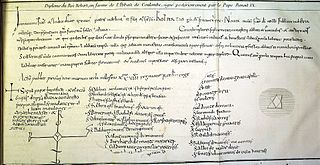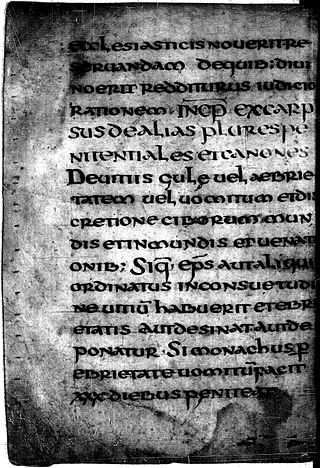Related Research Articles

Pope Alexander II, born Anselm of Baggio, was the head of the Roman Catholic Church and ruler of the Papal States from 1061 to his death in 1073. Born in Milan, Anselm was deeply involved in the Pataria reform movement. Elected according to the terms of his predecessor's bull, In nomine Domini, Anselm's was the first election by the cardinals without the participation of the people and minor clergy of Rome. He also authorized the Norman Conquest of England in 1066.

Pope Benedict IX, born Theophylactus of Tusculum in Rome, was the bishop of Rome and ruler of the Papal States for three periods between October 1032 and July 1048. Aged about 20 when first elected, he is the youngest pope in history. He is the only person to have been Pope more than once and the only person ever accused of selling the papacy.
Simony is the act of selling church offices and roles or sacred things. It is named after Simon Magus, who is described in the Acts of the Apostles as having offered two disciples of Jesus payment in exchange for their empowering him to impart the power of the Holy Spirit to anyone on whom he would place his hands. The term extends to other forms of trafficking for money in "spiritual things".
Clerical celibacy is the requirement in certain religions that some or all members of the clergy be unmarried. Clerical celibacy also requires abstention from deliberately indulging in sexual thoughts and behavior outside of marriage, because these impulses are regarded as sinful. Vows of celibacy are generally required for monks and nuns in Christianity, Buddhism, Hinduism, Jainism and other religions, but often not for other clergy.

Marriage in the Catholic Church, also known as holy matrimony, is the "covenant by which a man and woman establish between themselves a partnership of the whole of life and which is ordered by its nature to the good of the spouses and the procreation and education of offspring", and which "has been raised by Christ the Lord to the dignity of a sacrament between the baptized". Catholic matrimonial law, based on Roman law regarding its focus on marriage as a free mutual agreement or contract, became the basis for the marriage law of all European countries, at least up to the Reformation.
The Gregorian Reforms were a series of reforms initiated by Pope Gregory VII and the circle he formed in the papal curia, c. 1050–80, which dealt with the moral integrity and independence of the clergy. The reforms are considered to be named after Pope Gregory VII (1073–85), though he personally denied it and claimed his reforms, like his regnal name, honoured Pope Gregory I.

John IV, also known as John Nesteutes, was the 33rd bishop or Patriarch of Constantinople. He was the first to assume the title Ecumenical Patriarch. He is regarded as a saint by the Eastern Orthodox Church which holds a feast on September 2.
The canon law of the Roman Catholic Church requires that clerics "observe perfect and perpetual continence for the sake of the kingdom of heaven". For this reason, priests in Roman Catholic dioceses make vows of celibacy at their ordination, thereby agreeing to remain unmarried and abstinent throughout their lives. The 1961 document entitled Careful Selection and Training of Candidates for the States of Perfection and Sacred Orders stated that homosexual men should not be ordained. In 2005, the Church clarified that men with "deeply rooted homosexual tendencies" cannot be ordained. The Vatican followed up in 2008 with a directive to implement psychological screening for candidates for the priesthood. Conditions listed for exclusion from the priesthood include "uncertain sexual identity" and "deep-seated homosexual tendencies".
Christian leaders have written about male homosexual activities since the first decades of Christianity; female homosexual behavior was almost entirely ignored. Throughout the majority of Christian history, most Christian theologians and denominations have considered homosexual behavior as immoral or sinful.

A penitential is a book or set of church rules concerning the Christian sacrament of penance, a "new manner of reconciliation with God" that was first developed by Celtic monks in Ireland in the sixth century AD. It consisted of a list of sins and the appropriate penances prescribed for them, and served as a type of manual for confessors.

The pataria was an eleventh-century Catholic movement focused on the city of Milan in northern Italy, which aimed to reform the clergy and ecclesiastic government within the city and its ecclesiastical province, in support of papal sanctions against simony and clerical marriage. Those involved in the movement were called patarini, patarines or patarenes, a word perhaps chosen by their opponents, the etymology of which is uncertain. The movement, associated with urban unrest in the city of Milan, is generally considered to have begun in 1057 and ended in 1075.
Among the world's religions, views on masturbation vary widely. Some religions view it as a spiritually detrimental practice, some see it as not spiritually detrimental and others take a situational view. Among these latter religions, some view masturbation as allowable if used as a means towards sexual self-control, or as part of healthy self-exploration, but disallow it if it is done with motives they consider to be wrong, or as an addiction. For example, Christian denominations have different views on masturbation. Today, Roman Catholic, Eastern Orthodox, Oriental Orthodox and some Protestant Christians consider masturbation to be a sin. Many Protestant churches in Northern and Western Europe and some Protestant churches in Northern America and in Australia/New Zealand see masturbation as not a sin.
The Catholic Church condemns same-sex sexual activity and denies the validity of same-sex marriage. While the Church opposes "unjust" discrimination against homosexual persons, it supports what it considers "just" discrimination in the employment of teachers or athletic coaches, in adoption, in the military and in housing. The Catechism of the Catholic Church promulgated by Pope John Paul II considers sexual activity between members of the same sex to be a grave sin against chastity and sees homosexual attraction as objectively disordered. However, the Catechism also states that homosexuals "must be accepted with respect, compassion, and sensitivity". This teaching has developed through papal interventions, and influenced by theologians, including the Church Fathers.
Ecclesiastical prisons were penal institutions maintained by the Catholic Church. At various times, they were used for the incarceration both of clergy accused of various crimes, and of laity accused of specifically ecclesiastical crimes; prisoners were sometimes held in custody while awaiting trial, sometimes as part of an imposed sentence. The use of ecclesiastical prisons began as early as the third or fourth century AD, and remained common through the early modern era.

Sex and gender roles in the Roman Catholic Church have been the subject of both intrigue and controversy throughout the Church's history. The cultural influence of the Catholic Church has been vast, particularly upon Western society. Christian concepts, introduced into evangelized societies worldwide by the Church, had a significant impact on established cultural views of sex and gender roles. Human sacrifice, slavery, infanticide and polygamy practiced by cultures such as those of the Roman Empire, Europe, Latin America and parts of Africa came to an end through Church evangelization efforts. Historians note that Catholic missionaries, popes and religious were among the leaders in campaigns against slavery, an institution that has existed in almost every culture and often included sexual slavery of women. Christianity affected the status of women in evangelized cultures like the Roman Empire by condemning infanticide, divorce, incest, polygamy and marital infidelity of both men and women. Some critics say the Church and teachings by St. Paul, the Church Fathers, and scholastic theologians perpetuated a notion that female inferiority was divinely ordained, while current Church teaching considers women and men to be equal, different, and complementary.

The Excarpsus Cummeani, also called the Pseudo-Cummeani, is an eighth-century penitential, probably written in the north of the Frankish Empire in Corbie Abbey. Twenty-six copies of the manuscript survive; six of those were copied before 800 CE. It is possible that the penitential, which extends its scope beyond monasticism to include clerics and lay people, has a connection to Saint Boniface and his efforts to reform the Frankish church in the first half of the eighth century. Geographic spread by the end of the eighth century and continued copying of the manuscript into the 9th and 10th centuries have been interpreted to mean the work was considered "by the Christian authorities" a canonical text. It was used as late as the eleventh century, "as the main source of the P. Parisiense compositum.
In medieval Europe, attitudes toward homosexuality varied from region to region, determined by religious culture; the Catholic Church, which dominated the religious landscape, considered, and still considers, sodomy as a mortal sin and a "crime against nature". By the 11th century, "sodomy" was increasingly viewed as a serious moral crime and punishable by mutilation or death. Medieval records reflect this growing concern. The emergence of heretical groups, such as the Cathars and Waldensians, witnesses a rise in allegations of unnatural sexual conduct against such heretics as part of the war against heresy in Christendom. Accusations of sodomy and "unnatural acts" were levelled against the Order of the Knights Templar in 1307 as part of Philip IV of France's attempt to suppress the order. These allegations have been dismissed by some scholars.
Peter Damian, OSB was an Italian reforming Benedictine monk and cardinal in the circle of Pope Leo IX. Dante placed him in one of the highest circles of Paradiso as a great predecessor of Francis of Assisi and he was declared a Doctor of the Church on 27 September 1828. His feast day is 21 February.
The Christian tradition has generally proscribed any and all noncoital genital activities, whether engaged in by couples or individuals, regardless of whether they were of the same or different sex. The position of the Roman Catholic Church with regards to homosexuality developed from the writings of Paul the Apostle and the teachings of the Church Fathers. These were in stark contrast to contemporary Greek and Roman attitudes towards same-sex relations which were more relaxed.
The Liber Gratissimus is a treatise by Peter Damian on simony. Written in 1052, it has been described as "one of the finest theological works of the century."
References
- 1 2 3 Paul Halsall: Peter Damian: Liber Gomorrhianus Medieval Sourcebook. April 2006.
- ↑ Weber, Nicholas. "Simony." The Catholic Encyclopedia. Vol. 14. New York, New York: Robert Appleton Company, 1912. 31 January 2015.
- ↑ Tertullian, De pudicitia, 4.
- 1 2 3 4 Hoffman, Matthew Cullinan. "St. Peter Damian’s battle against clerical homosexuality offers useful lessons for today", Catholic World Report, September 27, 2018
- ↑ Thomas P. Doyle: "Roman Catholic Clericalism, Religious Duress, and Clergy Sexual Abuse," in Pastoral Psychology, Vol. 51, No 3, January 2003.